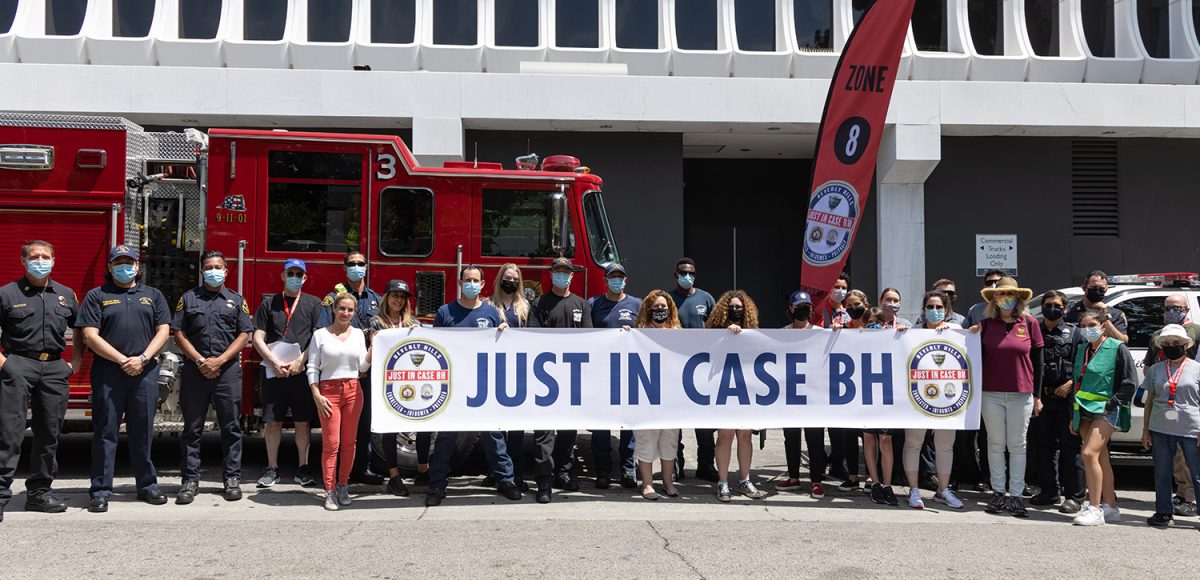Just In Case BH, the city’s neighborhood-based emergency preparedness program that connects residents, businesses and city agencies in the event of city-wide disasters, has released a manual for how to deal with a wide range of emergency situations. An online version of the manual is available now, but Just In Case BH plans to distribute hard copies to every home in the city around April.
“We want [residents] to have information at their fingertips on what to do if an emergency occurs,” Beverly Hills Fire Department (BHFD) Chief Greg Barton told the Courier.
The 88-page document begins with an explanation of the Just In Case BH program and command structure. It includes basic but potentially life-saving information on how to stop a bleed, treat burns, care for wounds, and apply a splint. The manual also provides guidelines on what to do in the event of extreme heat, a hazardous materials incident, an earthquake, a terrorist attack, or – knock on wood – a pandemic.
“Just In Case BH is comprised of residents and members of the business sector who are disaster volunteers and serve as backup to the City’s first responders in the immediate aftermath of a major emergency disaster,” the manual reads. “The program provides a roadmap to self-sufficiency by training volunteers and empowering the community to work together.”
The City Manager, Fire Chief, Police Chief, and the city’s Public Information Office, headed by the Chief Communications Officer Keith Sterling, collectively make up Unified Command. Unified Command interfaces with a north and south coordinator, who oversee the zones to the north and south of Santa Monica Boulevard, respectively.
The program then divides the city into nine geographical zones, each with a zone coordinator. Each of the nine zones also has an emergency meeting location that is stocked with emergency supplies and can serve as an evacuation center, if necessary.
Below zone coordinators are neighborhood coordinators, who are responsible for three to seven blocks. Finally, each block has a block captain.
The structure is designed to circulate verified information both from the bottom up and the top down as efficiently as possible during moments of crisis.
The manual lays out additional roles beyond those in the chain of command, including search and rescue, communications volunteers, and Certified Emergency Response Training volunteers.
The bulk of the manual provides instructions on how to manage a range of disaster situations and smaller problems.
“The manual covers a bunch of different things that residents could deal with–not only in a major disaster, but just on day-to-day stuff, such as how to stop a bleed, how to deal with wounds, how to deal with splinting, how to deal with insect bites and stings,” Barton said. “We want to make the community as self-sufficient as possible.”
Barton hopes the manual will demystify and make accessible information that some could find intimidating.
“It just basically empowers them to be that first responder,” he said. “The first responder, years ago, used to be the police department and fire department. Nowadays, it’s the person who’s right next to you or your neighbor.”
Vice Mayor Lili Bosse, who first proposed the program in 2020, saw the manual as part of her larger emphasis on health and wellness.
“Being a healthy city has always been our priority and that includes being a prepared city. I am thrilled and excited that our community will finally have everything needed ‘Just in Case’ any emergency happens,” Bosse told the Courier in a statement. “Everyone will know what to do, where to go and how to help each other.”
Vera Markowitz, Just In Case BH Program Coordinator, told the Courier that printing and distributing the manual will be no small feat. With a manual going to each home in the city, Just In Case BH is planning to print around 17,000 copies and hopes to distribute them all sometime in April, though a firm date has not been announced.
“This program is the only one of its kind in the entire country, where you can have a hard copy of what to do in an emergency at your front door,” she said.
The manual contains information that might not occur to you until the event of an actual disaster. For instance, what to do with animal loved ones. (They should not be left behind in a disaster, but do not risk your own safety trying to find them – also, most emergency shelters do not allow pets, except service animals, so look up pet shelters and hotels that allow animals in advance.)
Extreme heat, which is a period of over 90-degree heat for two to three days, is responsible for more deaths annually than any other kind of weather-related event. The manual provides bullet points on how to stay safe in the event of extreme heat, including covering windows with drapes or even aluminum-foil covered cardboard, going to a library, and drinking water.
Counterintuitively, you should not use electric fans when outside temperatures rise above 95 degrees. While fans may improve comfort, they do not reduce body temperature, making it harder to detect the symptoms of heat related illness.
Barton says that the most important information is on the first page.
“It shows the zone that they’re in,” he said. “It also shows their emergency meeting location, where the city is going to be providing first aid supplies and we’re working on getting health care providers who live in the area to help deal with first aid issues.”
Even as the program continues ramping up, it has attracted attention beyond the border of Beverly Hills.
“It’s being looked at the state level as a potential [program] to be piloted throughout the state,” Barton said, explaining that State Senator Henry Stern (D-Calabasas) has had conversations with the city about the program.







